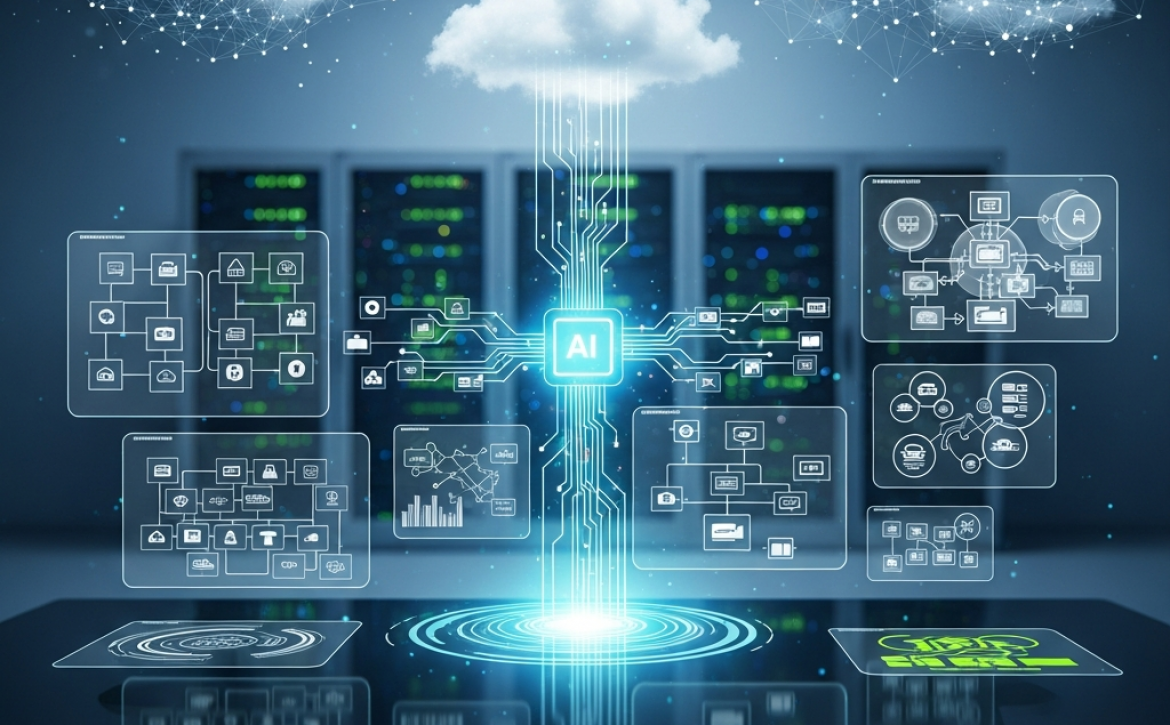SMB AI automation IT consulting guide
AI Automation for SMB Productivity and Security: How Microsoft, Google & SaaS Are Changing the Game
Estimated reading time: 10 minutes
Key takeaways
- AI is now a baseline capability for small and midsize businesses that want to compete on productivity, security, and customer experience.
- Embedded AI in Microsoft 365, Google Workspace, and core SaaS delivers the safest and fastest path to impact for most SMBs.
- Security and data governance must evolve alongside AI adoption, with stronger identity, email, and log analytics controls.
- Agentic AI, hyperautomation, and no-code platforms are making end-to-end business automation accessible to lean SMB teams.
- Eaton & Associates helps Bay Area SMBs design secure AI roadmaps, integrate tools, and operationalize automation in real workflows.
Table of contents
- AI automation for SMB productivity and security: why it matters now
- Microsoft: AI automation and security for modern SMBs
- Google Workspace: embedded AI and security for cloud-native SMBs
- SMB-focused AI SaaS: productivity and workflow automation
- Security and compliance: the foundation for safe AI adoption
- Broader trends: agentic AI, hyperautomation, and no-code
- Practical takeaways: how SMBs should approach AI automation and security
- How Eaton & Associates can help your SMB harness AI securely
- Ready to turn AI buzz into real productivity and security gains?
- FAQ
AI automation for SMB productivity and security: why it matters now
AI automation for SMB productivity and security is moving from buzzword to baseline. For small and midsize businesses in the San Francisco Bay Area and beyond, AI is no longer a nice to have. It is quickly becoming the only way to compete on speed, security, and customer experience.
Recent research shows:
- Around 62% of SMBs already use AI tools to compete with larger firms (source: AI tools for small business transformation).
- In ASEAN, 75% of SMBs investing in AI are 1.8× more likely to experience growth, and 90% report improved efficiency (source: Salesforce 2025 SMB trends).
- As they adopt AI, 66 to 76% of SMBs are increasing investment in data management and security (source: Salesforce 2025 SMB trends).
In other words, AI and security are now tightly linked.
At Eaton & Associates Enterprise IT Solutions, we see this every day with Bay Area clients on Microsoft 365, Google Workspace, and a growing stack of SMB SaaS. The pattern is clear:
- AI boosts productivity by automating repetitive tasks like invoicing, scheduling, reporting, and data entry (sources: BizTech on AI tools for small business, Clixie on AI productivity tools).
- AI improves customer experience with more personalized marketing, support, and sales outreach (sources: Clixie on AI productivity tools, Salesforce 2025 SMB trends).
- AI strengthens security, detecting phishing, malware, account compromise, and anomalous behavior at a scale no SMB IT team can match manually (sources: BizTech on AI security tools, Salesforce 2025 SMB trends).
This post walks through how AI automation for SMB productivity and security is evolving across:
- Microsoft 365 and Dynamics 365
- Google Workspace and cloud security
- SMB focused SaaS and AI agent platforms
- Emerging trends like agentic AI, hyperautomation, and no code
We close with practical steps office managers, IT leaders, and business executives can take over the next 6 to 12 months and how Eaton & Associates services can help you get there safely.
Microsoft: AI automation and security for modern SMBs
Microsoft 365 Copilot and the rise of agentic business apps
Microsoft 365 Copilot embeds AI directly into tools your team already uses: Word, Excel, PowerPoint, Outlook, and Teams.
For SMBs, Copilot can:
- Draft documents and emails from prompts or existing content.
- Summarize email threads and Teams chats so staff can catch up in minutes instead of hours.
- Generate PowerPoint decks from Word documents or bullet points.
- Analyze Excel data to surface trends, create formulas, and automate repetitive data tasks (source: BizTech on AI tools for small business).
Experts recommend that SMBs start with AI embedded into tools they already use, such as Microsoft 365 or CRM, as the safest and most productive way to adopt AI, rather than scattering data across unvetted, standalone tools (source: BizTech on AI adoption best practices).
Microsoft is also promoting agentic business applications in Dynamics 365 and the Power Platform. According to Microsoft (source: the era of agentic business applications):
- AI agents can monitor signals, trigger workflows, and coordinate tasks across systems like CRM, ERP, and custom apps.
- These agentic apps are a step toward AI first autonomous enterprises.
- The same platform is designed to scale down to SMBs using Dynamics 365 and Power Platform.
What this means for smaller organizations
With the right configuration and governance, even a 25 to 250 person company can:
- Auto generate quotes, invoices, and CRM entries from incoming emails or form submissions.
- Orchestrate workflows such as:
Lead capture → scoring → salesperson assignment → outreach sequence → follow up tasks. - Use Power Automate and Power Apps as low code tools to wrap AI around existing processes without needing a full development team.
From a consulting perspective, this is where we see huge gains: combining Microsoft 365 Copilot, Dynamics 365, and Power Platform into tailored automation that maps to your actual business processes instead of generic templates.
Microsoft-aligned AI security: email, identity, and log analytics
As AI tools proliferate, attackers are also getting more sophisticated. AI powered security solutions tightly integrated with Microsoft environments are becoming essential.
Two commonly used by SMBs:
- Proofpoint AI for email security
- Uses behavioral AI, deep learning, large language models (LLMs), and NLP to analyze email data.
- Detects phishing, business email compromise (BEC), and other threats that bypass legacy filters.
- Focuses on the biggest SMB attack vector: people, especially finance, HR, and executives (source: BizTech on AI security tools).
- Splunk with AI powered security and observability
- Ingests logs and event data from servers, cloud services, and applications.
- Applies ML and AI to detect both security incidents and infrastructure issues in real time.
- Gives SMBs SOC style analytics without building a 24×7 internal SOC (source: BizTech on AI security tools).
Key attributes SMBs care about include:
- Scale and speed of detection that manual review cannot match.
- Tight integration into Microsoft 365, Azure AD / Entra ID, and common SaaS tools.
- Centralized identity and access control so IT teams are not managing a fragmented security patchwork.
For Eaton & Associates clients, we typically layer:
- Microsoft 365 security controls such as MFA, Conditional Access, Defender for Office 365, and DLP.
- Proofpoint or equivalent for advanced email defense.
- Log analytics (often Azure Sentinel or Splunk) tuned to SMB scale environments.
This combination delivers enterprise grade protection without enterprise grade overhead.
Google Workspace: embedded AI and security for cloud-native SMBs
Many Bay Area startups and professional services firms run primarily on Google Workspace rather than Microsoft.
Google’s AI capabilities, now branded under Gemini (formerly Duet AI), are integrated across:
- Gmail for drafting and summarizing emails and suggesting replies.
- Docs for generating and refining content and summarizing long documents.
- Sheets for analyzing data, suggesting formulas, and automating chart creation.
- Meet & Chat for summarizing meetings and conversations and highlighting action items.
This mirrors Microsoft’s philosophy: bring AI to where users already spend their time to minimize change management and training (source: BizTech on embedded AI tools).
On the security side, Google relies heavily on AI and ML for:
- Spam and phishing detection in Gmail.
- Attachment and URL scanning.
- Context aware access controls based on device, location, and user risk.
- Anomaly detection and identity protection for Workspace accounts (sources: BizTech on AI security tools, Salesforce 2025 SMB trends).
For a Google centric SMB, this means:
- You already have a strong AI driven security baseline, but still need proper configuration and monitoring.
- You can safely introduce AI productivity features such as Gemini for Workspace within your existing compliance and security perimeter.
- You should integrate Workspace with AI aware tools in other areas such as CRM, ticketing, and accounting to avoid data silos.
Eaton & Associates IT consulting services also work with mixed environments. Many organizations run Google Workspace for collaboration but rely on Microsoft Azure, AWS, or other platforms for infrastructure. In those cases, we design cross platform automation and security architectures that keep identities, logs, and policies coherent.
SMB-focused AI SaaS: productivity and workflow automation
A major trend in 2025 is that SMBs are turning to off the shelf SaaS with embedded AI, instead of building custom AI models or hiring data science teams.
Multiple sources across the SMB landscape confirm this pattern, including Clixie on AI productivity tools, BizTech on AI tools for small business, Salesforce 2025 SMB trends, AI tools for small business transformation, top AI agent platforms for SMBs, and TextExpander on AI productivity tools.
Horizontal productivity tools
Common categories and benefits include:
- Content and communication generation
- Tools like ChatGPT, Jasper, and similar AI writers help create:
- Blogs, social posts, and ad copy.
- Sales proposals and pitch decks.
- Customer support replies and knowledge base articles.
- One agency cited cutting blog production time by 60% using Jasper (source: Clixie on AI productivity tools).
- Tools like ChatGPT, Jasper, and similar AI writers help create:
- Knowledge management and collaboration
- Notion AI organizes notes, tasks, and documents with intelligent summaries and search (source: Clixie on AI productivity tools).
- ClickUp AI combines project management, docs, and automation into a single command center, with AI agents assisting across tasks and workflows (sources: Clixie on AI productivity tools, AI tools for small business transformation, top AI agent platforms for SMBs).
- Meeting and time saving tools
- AI meeting assistants transcribe calls, extract action items, and schedule follow ups, now common for remote and hybrid teams (source: AI tools for small business transformation).
The impact of these tools includes:
- Direct labor hour savings. One ecommerce SMB saved 15+ hours per week by automating bookkeeping and data entry (source: Clixie on AI productivity tools).
- Reduced app sprawl when tools like ClickUp replace multiple point solutions, simplifying IT management and security (source: AI tools for small business transformation).
From an IT consulting standpoint, the key is curation and integration: choosing the right handful of AI driven tools and connecting them securely to your Microsoft or Google backbone.
AI agent platforms for SMBs
A newer but fast growing category is AI agent platforms. These tools do not just generate text, they actually take actions across systems.
According to top AI agent platforms for SMBs and Microsoft’s era of agentic business applications, SMBs look for platforms that offer:
- Deep integrations with CRM, email, calendars, ticketing, and accounting, so data flows across systems.
- Multi step automation that can handle full processes such as:
- Lead intake and qualification.
- Customer onboarding sequences.
- Subscription renewals and upsells.
- Robust security and compliance controls to protect customer and financial data.
Strategically, these platforms do more than automate busywork. They:
- Keep teams aligned.
- Ensure decisions turn into action.
- Create reusable processes that scale with growth (source: top AI agent platforms for SMBs).
Eaton & Associates IT consulting services help clients evaluate whether to build similar agentic flows inside Microsoft Power Platform or Dynamics 365, use a third party agent platform, or combine both, depending on budget, industry, and regulatory requirements.
Security and compliance: the foundation for safe AI adoption
As AI spreads across your stack, data protection and governance become non negotiable.
Rising investment in data management and security
Salesforce’s 2025 SMB trends report highlights that in ASEAN:
- 76% of SMBs are increasing investment in data management.
- 66% are investing to ensure data is complete, accurate, and secure.
Top concerns for SMB leaders adopting AI include:
- Protecting customer and financial data.
- Complying with industry and data protection regulations.
- Understanding how vendors handle and use their data (sources: Salesforce 2025 SMB trends, top AI agent platforms for SMBs).
This aligns with what we see in the Bay Area: high growth firms are willing to invest in AI, but only if security and compliance keep pace.
AI-driven security tools in practice
Across sources like BizTech on AI tools for small business, Salesforce 2025 SMB trends, AI tools for small business transformation, and top AI agent platforms for SMBs, common elements of a modern SMB security stack include:
- Email security
Proofpoint AI, Microsoft Defender for Office 365, and Gmail filters use behavioral analysis and NLP to block phishing, BEC, and malware. - Log and event analytics
Splunk and cloud native tools like Azure Sentinel and Google Chronicle use AI to flag suspicious activity and reliability issues in real time. - Platform level controls
Role based access control (RBAC), Data Loss Prevention (DLP), encryption, data retention policies, audit logs, and anomaly detection in Microsoft 365, Google Workspace, and CRM or ERP platforms.
When evaluating AI vendors, SMBs should consider:
- Proven security and compliance posture such as SOC 2 or ISO 27001 certifications and independent audits.
- Transparent data usage policies, including whether your data is used to train shared models.
- Regional hosting and compliance support for rules such as GDPR, CCPA, and sector specific regulations (sources: Salesforce 2025 SMB trends, top AI agent platforms for SMBs).
This is an area where a seasoned partner like Eaton & Associates adds real value: validating vendor claims, designing policies, and configuring technical controls to match your risk profile.
Broader trends: agentic AI, hyperautomation, and no-code
AI automation for SMB productivity and security is part of a broader shift in how work is organized.
McKinsey estimates AI could unlock $4.4 trillion in long term productivity gains across corporate use cases.
Key automation trends relevant to SMBs include:
- Hyperautomation
The combination of AI, robotic process automation (RPA), and workflow tools to automate end to end processes, not just individual tasks. This is especially valuable for finance, HR, operations, and customer service (source: CommunityForce business automation guide). - No code and low code automation
Platforms that let non technical staff build and adapt workflows quickly. These are critical for SMBs with lean IT teams and fast changing requirements (source: CommunityForce business automation guide). - Agentic AI
Appearing in enterprise platforms like Microsoft agentic apps and SMB tools such as AI agent platforms. Agentic AI delegates more complex, multi step work to AI agents that operate within guardrails (sources: Microsoft on agentic business applications, top AI agent platforms for SMBs).
Salesforce’s SMB research shows that high growth firms:
- Use AI driven insights to anticipate customer needs.
- Automate processes with AI and agentic tools to reduce manual work.
- Integrate systems to get rid of data silos.
- Invest early in data quality and security.
These are exactly the patterns we encourage when we design IT and AI roadmaps for clients.
Practical takeaways: how SMBs should approach AI automation and security
Whether you are an office manager, IT lead, or executive, here are concrete steps you can take over the next 6 to 12 months based on current research and on the ground experience.
1. Start where your team already works
- If you are on Microsoft 365, pilot Microsoft 365 Copilot in a few departments such as sales, operations, or leadership.
- If you are on Google Workspace, enable Gemini / Workspace AI for a pilot group.
Focus use cases include:
- Drafting and summarizing emails and documents.
- Meeting summaries and action items.
- Basic data analysis in Excel or Sheets.
This approach builds confidence while keeping data inside your governed environment (source: BizTech on AI tools for small business).
2. Layer specialized tools to fill key gaps
- Add email security such as Proofpoint AI or advanced Microsoft or Google controls to counter phishing and BEC.
- Implement log analytics via Splunk or cloud native tools for visibility across servers, cloud services, and endpoints (source: BizTech on AI security tools).
For productivity:
- Use AI enabled SaaS in marketing, CRM, help desk, and project management that already includes copilots or agents (sources: Clixie on AI productivity tools, AI tools for small business transformation, top AI agent platforms for SMBs, TextExpander on AI productivity tools).
3. Prioritize identity, email, and data security
This is non negotiable.
- Enforce MFA and conditional access in Microsoft 365 or Google Workspace.
- Enable DLP policies for sensitive fields such as PII, financial data, and PHI where applicable.
- Implement AI based phishing and anomaly detection for email and accounts (sources: BizTech on AI security tools, Salesforce 2025 SMB trends).
4. Introduce AI agents and automation gradually
Start with well bounded workflows such as:
- Lead intake and routing.
- Support ticket triage and FAQ responses.
- Invoice creation and follow up reminders.
Use no code automation tools such as Power Automate, Zapier style tools, or dedicated AI agent platforms that integrate with your CRM, email, and billing tools (sources: top AI agent platforms for SMBs, CommunityForce business automation guide).
Track simple metrics like time saved, response times, and error rates to prove value and justify expansion.
5. Evaluate vendors through a security and compliance lens
For each AI or SaaS vendor, verify:
- Encryption in transit and at rest.
- Role based access control and SSO integration.
- Data residency and compliance, such as SOC 2, ISO 27001, and HIPAA or PCI if relevant.
- Clear statements on how your data is used for training or model improvement (sources: Salesforce 2025 SMB trends, top AI agent platforms for SMBs).
This is where a partner providing IT consulting services can perform due diligence, negotiate terms, and ensure new tools align with your governance standards.
How Eaton & Associates can help your SMB harness AI securely
As a Bay Area based IT and AI consulting firm, Eaton & Associates Enterprise IT Solutions specializes in helping SMBs:
- Design AI automation strategies around Microsoft 365, Google Workspace, and core business SaaS.
- Implement and tune Microsoft 365 Copilot, Dynamics 365, Power Platform, or Google Workspace AI for real workflows.
- Consolidate and integrate SMB SaaS such as CRM, help desk, and project management to reduce app sprawl.
- Build agentic workflows and no code automation that your teams can own and adapt over time.
- Strengthen security and compliance with MFA, DLP, email security, log analytics, and ongoing monitoring.
Whether you are just starting with AI or ready to move toward more agentic, autonomous processes, we can tailor a 6 to 12 month roadmap based on your:
- Industry and regulatory requirements.
- Size and growth plans.
- Current Microsoft, Google, and SaaS footprint.
- Internal IT capacity.
Ready to turn AI buzz into real productivity and security gains?
If you are an office manager trying to reduce manual busywork, an IT professional tasked with securing a growing SaaS stack, or a business leader looking to scale without ballooning headcount, now is the time to put AI automation for SMB productivity and security to work on your terms.
Next step:
Schedule a conversation with Eaton & Associates to:
- Assess your current Microsoft 365 or Google Workspace environment.
- Identify 3 to 5 high impact AI automation opportunities.
- Map out a security first implementation plan tailored to your business.
Contact us today to explore Eaton & Associates’ Enterprise IT services and see how we can help your organization become more productive, resilient, and secure in the AI era.
FAQ
What is the fastest way for an SMB to get started with AI automation?
Answer: The fastest and safest path is to start with AI features built into platforms you already use, such as Microsoft 365 Copilot or Google Workspace Gemini. Focus first on drafting and summarizing content, meeting notes, and simple data analysis. This keeps data inside your existing security perimeter and requires minimal change management.
How can SMBs ensure AI tools do not compromise security or compliance?
Answer: Ensure you have MFA, conditional access, DLP, and email security in place before rolling out new AI tools. Evaluate vendors for encryption, access controls, compliance certifications, and clear data usage policies. A partner offering managed security and IT consulting services can help you validate and configure tools correctly.
What kinds of processes are best suited for AI agents in SMBs?
Answer: Start with repeatable, rules based workflows such as lead intake and routing, customer onboarding steps, support ticket triage, and invoice follow up. These processes are structured enough for agentic AI to handle reliably and have clear metrics like response time and error rate to measure impact.
Do SMBs need data scientists to benefit from AI and hyperautomation?
Answer: In most cases, no. Modern no code and low code platforms, along with AI enabled SaaS, are designed so business and IT staff can configure automations without data science teams. The main needs are clear processes, good data hygiene, and support from an experienced implementation partner.
How can Eaton & Associates support our AI and security roadmap?
Answer: Eaton & Associates can assess your current Microsoft 365 or Google Workspace setup, recommend AI and automation opportunities, implement tools like Copilot or Gemini, integrate key SaaS platforms, and strengthen your security stack with MFA, DLP, email security, and log analytics. We then help you build a 6 to 12 month roadmap that balances productivity gains with risk management.











